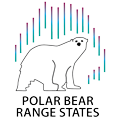- You are here:
-
Home

-
Resources

-
Meeting Documents

-
PBRS Meeting of the Parties (MoP)

-
2018 – Fairbanks, Alaska, USA

-
Presentations and Meeting Documents

- 7.3 Norway Research Report
7.3 Norway Research Report
Presentation Title: Polar bear research in Norway
Summary: In August 2015, the number of polar bears in the Norwegian part of the Barents Sea subpopulation was estimated via aerial line-transect «Distance» sampling. Separate estimates were created for the coastal areas and islands within the Svalbard Archipelago, and for the pack-ice area to the north, which was separated from the islands by approximately 100-200km of open water. Approximately 250 bears occurred within the islands of the archipelago, and genetic data suggest that these are mostly local bears. Another approximately 700 bears were estimated to be in the pack ice. This combined estimate was somewhat higher than an estimate conducted for these same areas in 2004, but the difference was not significant.
Polar bears in Svalbard are monitored through an annual capture-recapture program. Data on reproduction, condition, and on sea ice around denning areas are part of the monitoring program - Monitoring of Svalbard and Jan Mayen (MOSJ, www.mosj.no). Sea ice around traditionally important denning areas in east Svalbard has in recent years usually not formed in time to allow pregnant females to reach these areas in autumn in time for denning. Recent studies aim to reveal to what extent bears den in alternative areas of Svalbard instead, or whether a shift to Franz Josef Land, in the Russian Arctic has taken place. Snow drift modelling is being used to map available denning habitat based on weather data and topography. In Svalbard, studies on denning behavior are ongoing, based on both data from satellite telemetry collars and ear tag loggers, and, in cooperation with Polar Bear International, with video and still cameras at known denning sites.
Loss of sea ice has been particularly fast in the Barents Sea area (2-4 times the seasonal losses of elsewhere in the Arctic). A model on Research Selection Function (RSF) based on sea ice data and habitat use by adult female polar bears (based on satellite telemetry) showed that bears now select areas several degrees further north than earlier, further off-shore, and frequently over deeper and assumed less productive waters. Data on swimming behavior of female polar bears has shown that females frequently swim longer distances (>100km) between Svalbard and the ice edge because areas that used to be ice-covered most of the year now frequently have open water.
Researchers at the Centre for Evolutionary Ecology (CEFE, Montpellier, France) , in cooperation with the Norwegian Polar Institute, have developed a model to study reproduction and survival of polar bears, based on capture-recapture data. This provides a tool for future analyses on the effects of environmental factors on the demography of the subpopulation.
Genetic markers (microsatellites) developed for polar bears are used to identify individuals for capture-recapture, using samples collected via remote-biopsy darting. Y-chromosome markers from approximately 500 males are now available from our study area and are currently being used in analyzes of gene flow and spatial structure.
Ecotoxicology studies in the Barents Sea region have recently shown that concentrations of perfluorinated compounds in Barents Sea polar bears show stable trends. Studies on interactions between pollutants and climate change indicate that sea ice-associated declines in body condition can lead to increased concentrations of lipophilic pollutants in polar bears. Correlative field studies and in vitro studies indicate that polar bear lipid metabolism is affected by pollutants, and the effects of contaminants are more pronounced when environmental conditions are stressful.
| File Name: | 7.3_Aars_Norway_research_update.pdf |
| File Size: | 4.55 MB |
| File Type: | application/pdf |
| Hits: | 3814 Hits |
| Created Date: | 02-22-2018 |
| Last Updated Date: | 02-22-2018 |
Categories Tree
-
-
-
-
-
-
-
-
-
-
-
-
-
-
|- HBC-5 Output
-
|- HBC-7 Output
-
-
-
-
-
-
-
-
-
-
-
-
-
-
-
-
